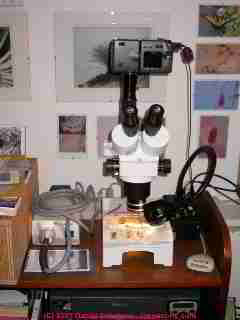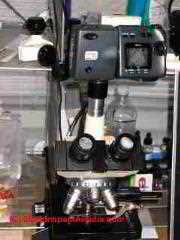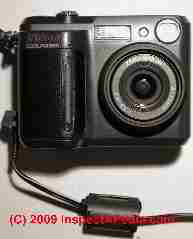 Guide to Digital Camera Selection for Microscopic Photography
Guide to Digital Camera Selection for Microscopic Photography
- POST a QUESTION or COMMENT about which digital cameras work best with microscopes
How to choose a digital camera for use with a microscope:
The purpose of this paper is to help microscopists photograph, store, and use digital microphotographs using modern digital cameras and transmitted-light microscopes.
Discussion focuses on selection of cameras adapt well to microscope eyepieces or trinocular heads, and on camera settings and procedures to obtain best quality photographs. We also discuss image resolution and size settings and make recommendations. Cameras used as examples in this paper include the Nikon Coolpix series 990, 995, and 4500.
[The photograph at page very top is one of our earliest attempts at photographing Aspergillus sp. using lacto phenol cotton blue stain. Even a beginner can obtain very good microphotographs with just a little care. The photograph shown here is of one of our stereoscopic microscopes in use for making digital photographs.
InspectAPedia tolerates no conflicts of interest. We have no relationship with advertisers, products, or services discussed at this website.
- Daniel Friedman, Publisher/Editor/Author - See WHO ARE WE?
Guide to Selection of Digital Cameras for Microphotography
 There are many digital cameras on the market that might work to make acceptable photomicrographs. We have found that the
Nikon Coolpix series (photo at left) has several advantages for through-eyepiece hand-held photomicrographs: the lens size fits
nicely on most eyepieces without scratching anything; the auto focus and other automatic settings produce excellent
photographs.
There are many digital cameras on the market that might work to make acceptable photomicrographs. We have found that the
Nikon Coolpix series (photo at left) has several advantages for through-eyepiece hand-held photomicrographs: the lens size fits
nicely on most eyepieces without scratching anything; the auto focus and other automatic settings produce excellent
photographs.
The techniques discussed in this paper work well with digital cameras and any type of microscope, low power stereo zoom to high power forensic polarized light microscopes.]
Digital microphotographs - camera recommendations: here we recommend specific digital cameras that work particularly well with microscopes.
PAAA 2005 Symposium, University of Tulsa, Tulsa Oklahoma - June 2-5, 2005 - updated 02/23/2009 - updated 2015/10/25 - updated 2015/10/25
Note: the latest version of this document can be found at
https://InspectAPedia.com/Microscopy/Digital_Photography_by_Microscope.php
© Daniel Friedman All Rights Reserved
Desirable Features for Digital Camera to Work with Microscopes
- The camera's parts that move when the camera is focusing should be internal.
- The camera's lens diameter should be close to that of the microscope eyepiece. In fact if you select one of the models we list just below, the camera's eyepiece is exactly the same as most microscope eyepieces - a feature that permits excellent hand-held photographs without requiring purchase and installation of an adapter to mount the camera front lens to the microscope eyepiece.
- The camera controls should be easily accessible when the camera is mounted on the microscope.
We have used the Nikon Coolpix models 990, 995, 4500 (page top photo and photo at left) with quite satisfactory results in preparing more than 750,000 digital photomicrographs and a large number of macro photos as well. The Nikon Coolpix 990, 995, and 4500 will work identically well though some of the menu settings are found in different places.
Camera Features that Do Not Work Well with Microscopes
 The Nikon Coolpix 850 (photo at left), and similar models from any manufacturer whose cameras employ external moving telescoping lens components are less successful for photomicrography. The sliding/telescoping barrel does not provide a rigid mount
against the microscope eyepiece.
The Nikon Coolpix 850 (photo at left), and similar models from any manufacturer whose cameras employ external moving telescoping lens components are less successful for photomicrography. The sliding/telescoping barrel does not provide a rigid mount
against the microscope eyepiece.
Though it's official macro-lens close-up range is not as close as the other two models, this camera's auto-focus is able to adjust itself for successful photomicrographs. These Nikon models are available as new, factory reconditioned, and used from EBay and from several large camera dealers at prices typically in the $300-$400. range depending on accessories included.
Cameras with an external telescoping lens barrel that moves in and out during focus adjustment. The camera lens focusing mechanism on most digital cameras that use this design is intended to move just the lens barrel and it is not intended to carry the entire weight of the camera.
Even though lens adapters can be purchase to adapt most cameras to a microscope eyepiece, if your camera is going to sit atop an eyepiece and then has to lift the entire camera body up and down as it attempts to auto-focus on the microscope image you are likely to damage the focusing mechanism.
We have also observed that the wobble and slack in movable external lens barrels on digital cameras may prevent good solid mounting and focus when used on a microscope.
Using other camera models made by Nikon, Canon, Kodak, or other manufacturers may be satisfactory, but we have found that the lens diameter and the internal rather than external telescoping parts of this Nikon 900/4500 series works particularly well for photomicrography.
Some of the Canon digital cameras have superb lenses and outstanding macro photography ability, but the large lenses on these cameras do not so perfectly fit the microscope eyepiece and field size. Other smaller hand-held digital cameras
We have used, such as the Canon digital elph can be used with the microscope but results were disappointing as the image formed is very small and telescoped. Microscopists may want to avoid some of the older small-pixel small-format earlier systems which produce only very small, low-resolution images.
Special systems which connect the camera output directly to a computer for on-computer image capture are particularly efficient for in-lab use. we have not (yet) included specifics on these features in this paper as herein we are focusing on image formation at the microscope and in the camera.
Camera mounts and trinocular heads for taking photographs through the microscope
Cameras with an appropriate front lens diameter can be hand-held against a microscope eyepiece to take successful photographs. Adapters which screw into the front of the camera lens and slide into a microscope eyepiece tube or into a trinocular head are a better approach for regular use in the laboratory.
We use four such cameras permanently mounted on microscopes in our lab, for example.
My mount supplier also provided a mount stabilizing ring which provided a more secure position on our trinocular stereoscope.
In a comparison test using the same camera hand-held at eyepiece and mounted on the trinocular head with two different adapters we observed no detectable difference in the image produced with eyepiece mounts and hand-held shots.
Digital Camera Features that Work Well with Microscopes
Question: are there newer model digital cameras with more pixels that work as well or better than the Nikon Coolpix 990, 995, and 4500 series?
I have read your interesting guide to selection of digital cameras for microphotography.You recommend the Nikon Coolpix models 990, 995, 4500 for their ease in use. Cameras of those models are still available. Do you know if any of the newer digital models with greater number of pixels are also compatible for microscopic photography. - Fred Colley, Pyxis Laboratories, LLC, Portland, OR
Reply:
We have followed with interest the continuing improvements in lenses, image chips, and other features in ensuing generations of digital cameras, and many of them produce superior photo images in general use. But for microphotography we have not encountered newer digital camera models with the following features that work particularly well with microscopes compared with the camera series we described above.
Relationship of Camera Lens Physical Size and Microscope Eyepiece - optics & stability
For the models included in the Nikon camera series we have described, the camera's front lens diameter is very close to the diameter of an eyepiece, so with an adapter it is optically efficient, stable, and not too heavy on the microscope. In fact when traveling to another lab, with no mounting adapter at all, if someone has something interesting in focus on their microscope, it takes only an instant to simply hold the camera lens against an eyepiece and snap a photo. This feature has been invaluable when attending conferences on or courses in microscopy when there is a room full of microscopists busily discovering interesting things.
Technical note: often one wants to make several exposures of an object being examined microscopically, capturing different object features as the microscope is focused up and down to display different areas on the three-dimensional object in view. For example, one can capture the surface decorations as well as internal features of a pollen grain or some mold spores.
Mechanical Stability and Stress on Camera Moving Parts When Mounted to a Microscope
Unlike other digital cameras whose front lens telescopes "out" from the camera body as focal length changes, all of the moving parts are inside the camera series we recommend above. As a result, when the camera with adapter is mounted onto the microscope it is not only stable, but there is no stress on any moving camera parts as it changes focus. If you zoom out other camera models and (gently) move the lens barrel you will see that those components are not very strong nor are they immune to lateral movement.
More Camera Pixels Does Not Necessarily Mean a Better Photographic Image
More pixels does not necessarily mean sharper images through the microscope. Many consumers are misled in this matter as manufacturers advertise higher pixel numbers for their newer camera models. The resolution ability of the camera lens as well as the design of the image-capturing chip remain the determinants of sharpness of photo images in general.
What more pixels does buy you is the ability to print a larger physical image on paper without loss of resolution, or the ability to zoom in and crop special features in a photograph. The camera series we describe, at the settings we usually use, easily produces high resolution 8" x 10" photographs. If you need to print larger images you will want to set the camera to its higher pixel or higher image size. If you are never printing large images nor cropping onto image features, capturing and storing 4 MB pixel images may be a waste of storage space. (Disk space is increasingly cheap however the time to backup, copy, move libraries still increases with the size of images stored.)
Importance of the Camera's Auto focus in Macro Mode for Microphotography
But more important in capturing sharp images in the microscope in digital photos is the ability of a particular camera model to focus optimally when attached to a microscope - a feather that also varies widely among cameras. The macro focus and auto focus ability of the Nikon series we mention works very well in this regard, so that even when the microscope is not focused perfectly for the camera (you focused it for your eye), the auto focus will often produce an improved, sharp image.
When Do We Set the Camera Focus on Infinity for Microphotography?
Only when the auto focus cannot find an object in the field of view suitable for auto focus do you need to set the camera focal length on infinity and then focus the microscope optimally for the camera by hand, watching the image sharpness on the camera's LCD screen. In this case as well, the Nikon series I recommend offer an added advantage.
Importance of the Camera's Rotating Body and/or Viewing Screen to 90 Deg. From the Lens Axis
Because the camera body can rotate 90 degrees from the axis of the lens itself, you can mount the camera facing down on a microscope eyepiece or on a trinocular head, while rotating the image screen vertically so that its image is easily seen by the operator seated at the microscope workbench.
Other model cameras that do not have a rotating body but that can mount with stability onto the microscope will present their viewing screen in the "up" position on the camera's back. Unless the viewing screen is one that can rotate to a more convenient position, the operator will have to stand up and perhaps even tiptoe to look "down" onto the screen for focusing or image checking.
In sum, as you can see in our photos above of a camera mounted on a microscope, the ability to aim the camera viewing screen comfortably towards a seated microscopist is a useful feature.
Alternative Camera Models for Microphotography
Although there are indeed lens adapters that can mount other digital cameras to a microscope, if you are not going to use one of the models I've described, you will want to go to a much larger, SLR type model that also incorporates a physically strong and stable lens whose moving parts are either internal or are much stronger than the small zooming digital cameras on the market.
Certainly we have no economic interest in recommending a particular piece of equipment, and if you find other camera models that work well in all of the regards I've discussed, I'd be very glad to add that information to our description, particularly because over time the availability of the models we have listed will surely decline.
We welcome any debate, opinion, or suggestion that adds to this information.
Reader Question: digital camera suitable for publishing cytology smears in a book or atlas
July 13, 2015) dr meena pangarkar said:
Which digital camera should be used to click microphotographs of cytology smears which can be printed in a book / atlas?
Ccan photos be taken with mobile phone cameras? what r the specifications ?
Reply:
Dr. Meena,
The cameras we recommend in this article series are quite suitable for just about any microphotographs;
I've photographed biological materials but also a very wide range of non-biological particles. Particularly with smears you want decent macro-focus and resolution.
A mobile phone camera will not provide a high-quality publishable photomicrograph even when using add-on smartphone lens attachments.
Don't confuse the high number of pixels offered by some digital media devices, including smartphones, with the actual high resolution of a recorded image that can be afforded by a high quality, larger-diameter glass camera lens that adapts well to a microscope.
I have indeed published some smartphone or mobile phone camera photos of building features (including here at InspectApedia.com) where super high resolution was less critical.
...
Continue reading at MICROSCOPE CAMERA SETTINGS or select a topic from the closely-related articles below, or see the complete ARTICLE INDEX.
Or see these
Recommended Articles
- FORENSIC LAB TECHNICAL PROCEDURES - home
- MICROSCOPE DIGITAL PHOTOGRAPHY
- TECHNICAL & LAB PROCEDURES
- WORLD TRADE` CENTER 9-11 DUST PHOTOS
Suggested citation for this web page
MICROSCOPE CAMERA SELECTION at InspectApedia.com - online encyclopedia of building & environmental inspection, testing, diagnosis, repair, & problem prevention advice.
Or see this
INDEX to RELATED ARTICLES: ARTICLE INDEX to BUILDING FORENSICS
Or use the SEARCH BOX found below to Ask a Question or Search InspectApedia
Ask a Question or Search InspectApedia
Try the search box just below, or if you prefer, post a question or comment in the Comments box below and we will respond promptly.
Search the InspectApedia website
Note: appearance of your Comment below may be delayed: if your comment contains an image, photograph, web link, or text that looks to the software as if it might be a web link, your posting will appear after it has been approved by a moderator. Apologies for the delay.
Only one image can be added per comment but you can post as many comments, and therefore images, as you like.
You will not receive a notification when a response to your question has been posted.
Please bookmark this page to make it easy for you to check back for our response.
Comments
IF above you see "Comment Form is loading comments..." then COMMENT BOX - countable.ca / bawkbox.com IS NOT WORKING.
In any case you are welcome to send an email directly to us at InspectApedia.com at editor@inspectApedia.com
We'll reply to you directly. Please help us help you by noting, in your email, the URL of the InspectApedia page where you wanted to comment.
Citations & References
In addition to any citations in the article above, a full list is available on request.
- Thanks to reader Fred Colley, Directory of Microscopy Dept., Pyxis Laboratories, LLC, Portland, OR for discussing microscopy and digital photography - August 2010. Mr. Colley writes that
I do a variety of microscopic analysis. I was trained in particle and asbestos analysis by Russ Crutcher (Microlabs NW) in Seattle. He was formerly the chief particle analyst at Boeing Corp. I was a microbiology/public health teacher and I do microbiology analysis including fungus identification. - In addition to citations & references found in this article, see the research citations given at the end of the related articles found at our suggested
CONTINUE READING or RECOMMENDED ARTICLES.
- Carson, Dunlop & Associates Ltd., 120 Carlton Street Suite 407, Toronto ON M5A 4K2. Tel: (416) 964-9415 1-800-268-7070 Email: info@carsondunlop.com. Alan Carson is a past president of ASHI, the American Society of Home Inspectors.
Thanks to Alan Carson and Bob Dunlop, for permission for InspectAPedia to use text excerpts from The HOME REFERENCE BOOK - the Encyclopedia of Homes and to use illustrations from The ILLUSTRATED HOME .
Carson Dunlop Associates provides extensive home inspection education and report writing material. In gratitude we provide links to tsome Carson Dunlop Associates products and services.


No one has commented yet. Be the first!